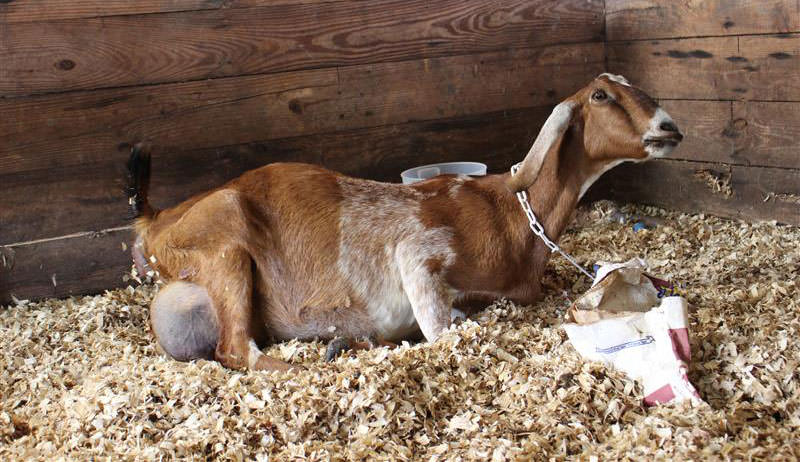
Kidding season is, paradoxically, both the most wonderful and most stressful time of the year. Nothing beats watching happy, healthy, bouncy kids find their footing and their jumping skills, but the journey to that point is not always smooth sailing. Most times, a doe in labor will successfully kid on their own, but occasionally they do require help. There is also a middle zone, where they may not technically need help, but will have a better experience and outcome with it.
What Labor Looks Like
The first thing to remember is that labor times vary. In our herd, some does will come back to the barn and have kids on the ground within 10 minutes. Others spend all day in various stages of what we consider “pre-labor.” This includes a lot of pawing at the ground, lying down, getting up, stretching and yawning. Our rule of thumb is to let this take its course. We define labor as the time elapsed after the first serious push. Not a “maybe that was a push, but maybe it was just a grunt,” but a serious, lip-curling, grunt-inducing series of two or more obvious pushes. And if we don’t see progress after 30 minutes, we go in to see what’s happening.
To clarify, we don’t expect kids on the ground after 30 minutes, but we do expect to see at least one of the following: thick ropes of goo, a bubble or a rush of broken water. These are obviously not technical terms, but they are ones you should recognize easily when looking for them.
When To Assist Your Laboring Doe
If there is bubble, we let labor proceed a while longer. Chances are if you see this sign, your doe will be OK to deliver on her own. Don’t break the bubble. It is going to help stretch out her cervix for delivery. If we see the water break, we go ahead and put a couple fingers inside to see if we can feel baby parts. If so, and if we feel front hooves and a nose, we wait. Things are going as planned. If we feel anything else, we assess the position and make decisions from there.
If we don’t feel anything, we go deeper to make sure the cervix is open or in the process of opening so kids can pass. If it feels roomy you can keep going to see if you can feel anything or wait a little bit longer and let her push a couple more times to get things closer to start assessing what you have. If you come to a closed cervix, you’ll know. You will be stopped by it, unable to go farther into her than a full hand or so. She’s not ready yet, but you also would not likely have seen any of the three signs we look for. You may want to call a vet, who can assist in dilating the cervix or explain to you how to help. Remember, this is something you’ll want to do after the doe in labor has been pushing for 30 minutes. It’s time to get proactive. After 20-plus births a year for 10 years, I have never seen a doe pushing for 30 minutes and found a closed cervix. but however rare it is, it is still a possibility.
If we feel back feet, that is a delivery the doe can do on her own, but it may take longer than a nose-first delivery. If you decide to pull here, that’s fine. Just be sure to pull in a downward motion. If your doe is still pushing, time your pulls with that. If not, you can slide your hand in around the baby a bit and the pressure will make her start to push again.
When A Doe In Labor Needs Your Help
Abnormal Presentation
If we feel anything other than those two presentations, we begin to assist in earnest. The internet is a rich and valuable resource of drawings and explanations of the different presentations and how to deal with them. I advise printing out the photos and directions to refer to in the event you feel something you have not dealt with before. A little prep goes a long way when it’s time to get those kids out manually.
Pushing Isn’t Working
If we felt front hooves and head (a perfect presentation) but lots of pushing is not getting the job done, we help. Sometimes the doe is delivering a very large kid. If it is alive, it almost always will come out eventually, but this is where we think it’s worth helping so your doe in labor does not get overly stressed.
The Doe In Labor Is Tired
I recently helped a friend pull a giant buck kid out of a first freshener (a first-time mom). By the time I got there, she had quit pushing. She was exhausted. I am guessing she would have eventually gotten the baby out, but there is no way to know that for sure or what cost to the doe. It took all of my strength to get the head out, and the doe looked 100-percent relieved when that happened. I would make this decision every time. I generally pull kids any time a body part has come out and gone back in more than a few times. That doe is tired.
That’s how we do things, but each farm has to do what feels right for them. We may be more proactive than most, but we also don’t lose does during kidding and have only lost one shortly after, in a messy case of dead triplets that had to be pulled. I don’t think it’s coincidence. The No. 1 rule, no matter how proactive you get, is don’t panic. A clear head will help get you all through this in the best possible way. And again, most times, delivery will go fine on its own.




